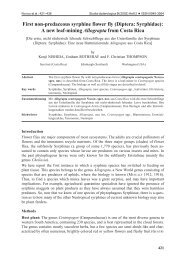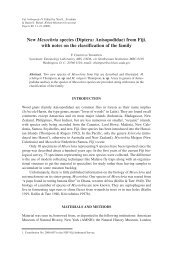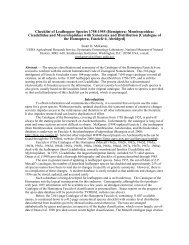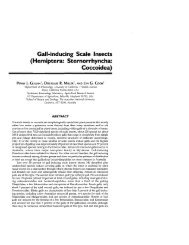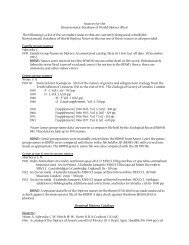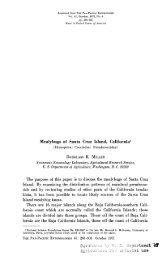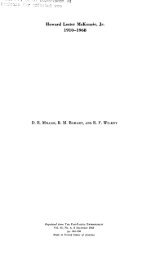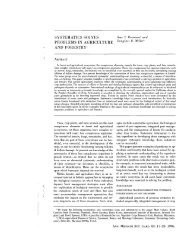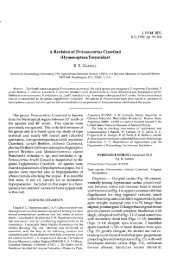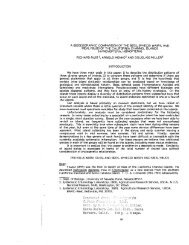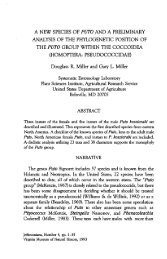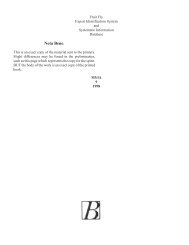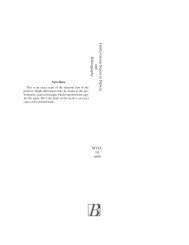Systematic revision of the Family Micrococcidae (Homoptera ...
Systematic revision of the Family Micrococcidae (Homoptera ...
Systematic revision of the Family Micrococcidae (Homoptera ...
Create successful ePaper yourself
Turn your PDF publications into a flip-book with our unique Google optimized e-Paper software.
203 <br />
with single central loculus or more than 1 central loculus. Parastigmatic<br />
pores, when present, comprising multilocular pores, occurring outside <strong>of</strong><br />
stigmatic plate. Intrastigmatic pores comprising multilocular pores, restricted<br />
to sclerotized plates surrounding spiracular atria. Invaginated tubular ducts<br />
<strong>of</strong> 2 sizes: broader ducts present on medial and submarginal areas <strong>of</strong> abdomen<br />
and metathorax; narrower ducts on medial and submarginal areas <strong>of</strong><br />
abdomen and head. Anal lobes modified into anal plates that surround anal<br />
ring. Anal lobe-like structures developed on segment VII with several long<br />
setae giving appearance <strong>of</strong> normal lobes. Legs with tibia and tarsus fused.<br />
GENERAL DESCRIPTION OF THIRD INSTAR FEMALE<br />
Description: Same as adult female except as follows. Body elongate oval.<br />
Longest ventral setae excluding those on body margin less than 25 (J. long.<br />
Multilocular pores each with 5 to more than 15 loculi. Parastigmatic pores<br />
usually absent. Invaginated tubular ducts absent. Vulva absent. Anal ring<br />
with more than 4 setae on each side; anal-ring pores in 2 rows.<br />
GENERAL DESCRIPTION OF SECOND INSTAR FEMALE<br />
Description: Same as third instar female except as follows. Multilocular<br />
pores each with 5 to more than 15 loculi. Parastigmatic pores present. Anal<br />
ring with fewer than 5 setae on each side; anal-ring pores absent or in 1<br />
row.<br />
GENERAL DESCRIPTION OF FIRST INSTAR<br />
Description: Body elongate. Abdominal segment VIII modified into sclerotized<br />
lobes which transform into plates in later instars; each lobe with a<br />
sclerotized bar and long apical seta. Antennae 5-segmented. Setae filamentous,<br />
with 2 pairs <strong>of</strong> longitudinal lines on each side <strong>of</strong> dorsum, with 3 pairs<br />
<strong>of</strong> lines on each side <strong>of</strong> venter. Bilocular pores absent. Multilocular pores<br />
with 5 to 9 loculi, without central loculus. Parastigmatic and intrastigmatic<br />
pores present. Discoidal pores present on both surfaces. Invaginated tubular<br />
ducts absent. Microtubular ducts present on submarginal area <strong>of</strong> venter,<br />
with conspicuous dermal orifice. Legs without sensillum on tarsus; tibia and<br />
tarsus separate; tibia divided by tarsus about 1.6; tarsal digitules staggered,<br />
not arranged side-by-side, apices acute or slightly enlarged; tarsal digitules<br />
on front legs each with 1 small filamentous seta and 1 enlarged seta; claw<br />
digitules each with 1 large seta, and 1 conspicuously smaller seta.



